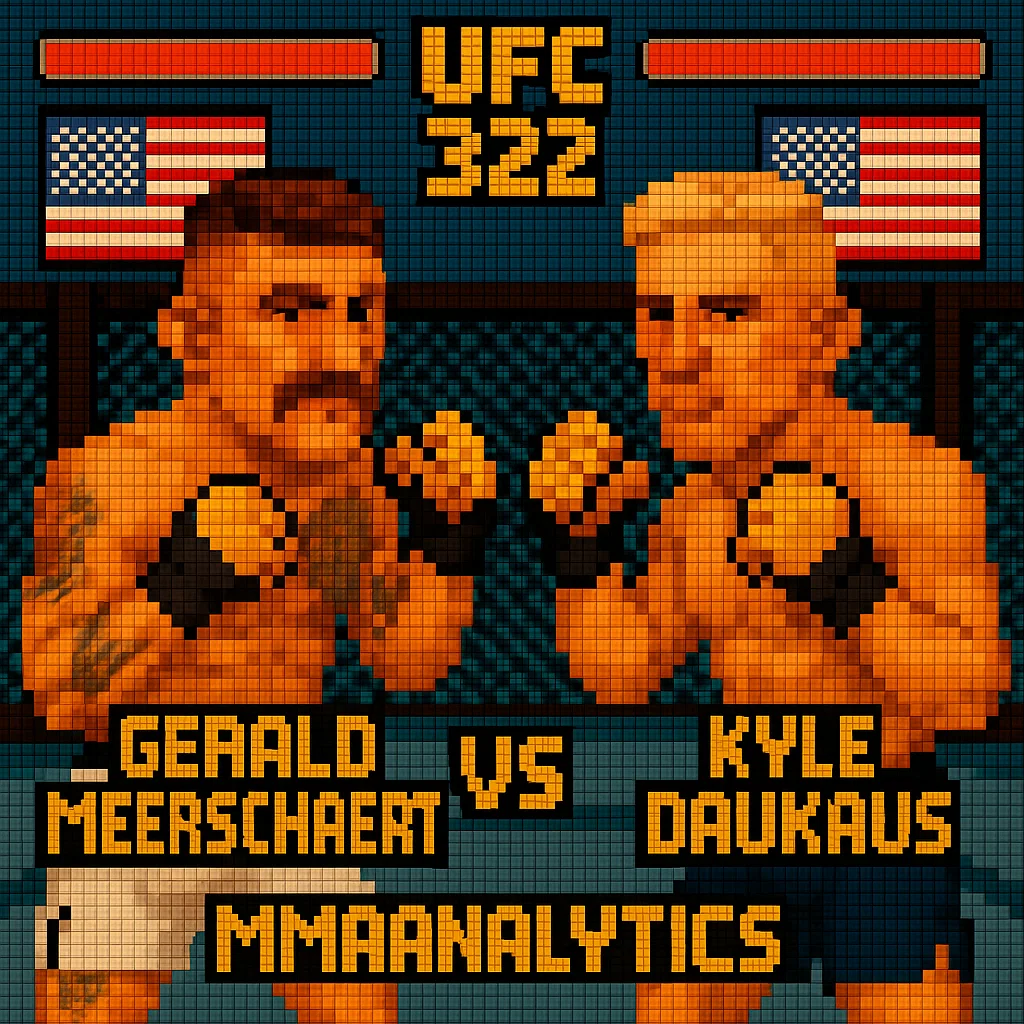Gerald Meerschaert vs Kyle Daukaus
UFC 322
Saturday, November 15, 2025

Explore Detailed Fighter Profiles
Click on either the fighter's name or profile image for each fighter to access comprehensive UFC statistics including striking metrics, grappling data, clinch performance, complete fight history, offensive & defensive analytics, and round-by-round breakdowns.
Fighter Metrics
Victory Methods
Win Round Distribution
Fighter Metrics
Victory Methods
Win Round Distribution
📋 Last 5 Fights - Gerald Meerschaert
| Date | Opponent | Result | Method |
|---|---|---|---|
| 2025-08-16 | Michał Oleksiejczuk | L | TKO - Punches (R1, 3:03) |
| 2025-04-05 | Brad Tavares | L | Decision - Unanimous (R3, 5:00) |
| 2024-11-09 | Reinier de Ridder | L | Submission - Arm-Triangle Choke (R3, 1:44) |
| 2024-08-24 | Edmen Shahbazyan | W | Submission - Arm-Triangle Choke (R2, 4:12) |
| 2024-03-16 | Bryan Barberena | W | Technical Submission - Face Crank (R2, 4:23) |
📋 Last 5 Fights - Kyle Daukaus
| Date | Opponent | Result | Method |
|---|---|---|---|
| 2025-08-23 | Michel Pereira | W | KO - Punches and Elbows (R1, 0:43) |
| 2024-06-14 | Keanan Patershuck | W | KO - Punches (R1, 1:24) |
| 2024-02-09 | Sean Connor Fallon | W | Submission - Brabo Choke (R3, 3:45) |
| 2023-09-02 | Gregg Ellis | W | Decision - Unanimous (R4, 5:00) |
| 2023-06-16 | Robert Gidron | W | Submission - Rear-Naked Choke (R1, 4:59) |
Technical Analysis
Technical Score
Cardio Score
Overall Rating
📊Technical Score
Calculated as the average of Striking Composite (48.5 vs 50.0) and Grappling Composite (37.5 vs 51.0). Combines overall striking effectiveness with grappling ability to measure complete technical skills.
💪Cardio Score
Based on average fight duration, striking rate per minute, takedown rate, and fight finish rate. Measures cardiovascular endurance and ability to maintain pace throughout fights.
🎯Overall Rating
Simple average of Technical Score and Cardio Score. Provides a holistic view of fighter capabilities combining skill level with physical conditioning and fight performance.
Striking Composite
Grappling Composite
🥊Striking Composite
Weighted combination of Significant Strikes per Minute (SLpM), Striking Accuracy (StrAcc), Striking Defense (StrDef), and Strikes Absorbed per Minute. Measures overall striking effectiveness including offensive output, precision, and defensive ability.
🤼Grappling Composite
Calculated from Takedowns per 15min (TD15), Takedown Accuracy (TDAcc), Takedown Defense (TDDef), and Submission Attempts per 15min (SubPer15). Evaluates complete grappling game including takedown ability, defensive wrestling, and submission threat.
Technical Radar Comparison
Metrics Legend
📊 Detailed Statistical Comparison
🥊 Fight Analysis Breakdown
🚀 Gerald Meerschaert Key Advantages
Front‑headlock and half‑guard chains; converts scrambles into finishes at a high clip.
High conversion once control is established; guillotine/arm‑triangle series end fights.
⚠️ Unfavorable Scenarios
Daukaus' 82% TDD blunts entries in space; big cage reduces fence starts.
In space, Daukaus' 52% accuracy and lower SApM favor minute‑winning.
📋 Likely Gameplan
Force clinches to shorten distance; chain to front‑headlock if sprawled.
Create exits and re‑entries to hunt necks; avoid long center‑cage exchanges.
🚀 Kyle Daukaus Key Advantages
Decides when/if the fight hits the mat; ideal in a 30‑ft cage.
Cleaner selection at range with lower SApM (2.94) supports round‑winning.
⚠️ Unfavorable Scenarios
GM3 converts messy transitions into submissions; keep positions clean.
Getting stuck in front‑headlocks can flip rounds quickly against GM3.
📋 Likely Gameplan
Keep it at range, sprawl early, circle off before fence engagements.
Minimize risk in grappling; avoid giving GM3 the scramble looks he wants.
🎯 Fight Prediction Analysis
Data-driven prediction model based on statistical analysis
🏅 Betting Analysis: Model vs Market
Comprehensive value assessment and betting opportunities
📊Market Odds
🤖Analytical Model
💎Value Opportunities
MAXIMUM VALUE
Model: 33% | Market: varies
GOOD VALUE
Model: 57% | Market: compare best line
SLIGHT VALUE
Model: 58% | Market: varies
⚠️Key Market Discrepancies
- • Overweights GM3's vulnerability — ignores that submissions, not KOs, are his primary weapon.
- • Undervalues Daukaus' TDD — 82% in a big cage materially lowers GM3's access.
- • Accuracy gap — 52% vs 45% can bank minutes even at low volume.
🎯 Comprehensive Probabilistic Analysis
100 hypothetical fight simulation based on statistical data
🏆Outcome Distribution - Kyle Daukaus
Minute‑winning at range
Clean counters early
Front‑headlock chains
🏆Outcome Distribution - Gerald Meerschaert
Primary finishing route
Lower minute‑winning profile
Less likely but present
⏰Fight Timeline Analysis
⚡Window of Opportunity - Kyle Daukaus
- • First 7–8 minutes: Best chance to bank minutes at range.
- • Sprawl first: Cross‑face immediately into exits.
- • Avoid clinch stalls: Circle before fence contact.
🎯Progressive Dominance - Gerald Meerschaert
- • Scramble equity: Later entries increase sub chances.
- • Fence usage: Compress space to trigger grappling.
- • Risk trade‑offs: Accept some strikes to access necks.
🎯 Final Confidence Assessment
Confidence level and uncertainty factors
Confidence Level
Stable edges (TDD, accuracy) vs live sub volatility
✅Supporting Factors
- • 82% TDD for Kyle Daukaus
- • 52% vs 45% striking accuracy gap
- • Lower SApM for Kyle Daukaus (2.94)
- • Gerald Meerschaert elite submission conversions
⚠️Risk Factors
- • Gerald Meerschaert submission‑or‑bust danger
- • Kyle Daukaus 42% strike defense
- • Scramble volatility
- • Middleweight variance
🏁Executive Summary
Kyle Daukaus carries the steadier round‑winning profile via elite takedown defense and cleaner accuracy, while Gerald Meerschaert's submission chains remain the single most dangerous weapon. In a 30‑ft cage over three rounds, the model leans 57–43 toward Kyle Daukaus, with Gerald Meerschaert's best equity tied to scramble‑generated submissions.
Prediction: Kyle Daukaus by Decision or Gerald Meerschaert by Submission.
